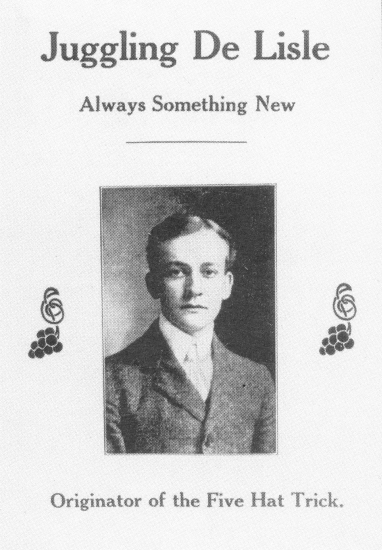 |
Page 40 Summer 1993
|
The
lightning Juggler Blazes
His Own Trail BY
JACK GREENE, FROM THE FEBRUARY 1953 IJA NEWSLETTER
Sandy
DeLisle was born in Glen Falls, N.Y., before 1890 and started to
juggle when he was eight years old. He was self-taught, and always
tried to be original in his presentation. He was not satisfied to copy
other acts but worked out many original ideas which he incorporated
into his act. His costuming appears to me to be entirely original,
consisting of a Scotsman's full kilts.
When
I was with the troupe Frear Bagget and Frear, we played on the bill
with Sandy in Atlantic City about 1913 at the Globe Theatre on a
Sunday. You may wonder why there were two juggling acts on the same
bill. I will explain it this way.
Around Philadelphia at that time in some of the houses your contract
called for a seven-day week. But Philadelphia did not run Sunday
shows, so to fill out the week you were transported to Atlantic City
to finish out the week - without extra pay. The booker for those
Atlantic City theatres would pick out acts without regard to
conflicting acts. Results? A duplication of acts.
One
of Sandy's tricks at that time impressed me very much. He would stand
on one side of the stage with a waste basket on the other side and a
cane-bottom chair in the middle. He would take a tennis ball and
bounce it on the floor so that it bounced off the chair,
then to the floor and from there into the wastebasket on the other
side of the stage. A very cute and clever trick.
Another
trick which stood out in my memory was the famous five high-hat
routine which he originated. He placed one hat on a hat tree, one in
each hand, one on his head and one on a foot. He would then pass the
hats from one position to the other as an ordinary juggler would
pass three high hats. It was really sensational!
I
first noticed his mirror clubs later on when I caught his act in
Lowell, Mass. The mirrors fastened to the clubs were the small round
kind common in those days. The house lights were out and he worked in
a spotlight. The effect of those mirrors on the revolving clubs was as
pretty a sight as one would want to see. His finish consisted of
throwing three clubs in the air as high as the stage would allow,
floating way up high on three turns. Then he would gradually bring
them down, down and down until they were spinning at a terrific rate
of speed, jumping around all the while. One would have to see it to
believe what the effect was. Known then as Billy DeLisle the Lightning
Juggler, he never failed to get his full share of applause with that
finish, many times stopping the show.
Sandy
originated all of those tricks and many more. Instead of three cigar
boxes he used two boxes and a large ball, saying he just had to be a
little different.
Sandy
started out with the Bennett and Moulton stock company, which was very
popular in the days before 1900. Those shows then
charged ten, twenty and thirty cents for admission, and were called,
ten, "twent" and "thirt" shows. The vaudeville
acts were presented between acts of the play. In the summer he would
play the parks, which were popular at that time. They were for the
most part operated by street car companies. The gimmick was to have
people ride on the cars to and from the park, so the parks naturally
were placed on the outskirts of town or a few miles out so that it
would be too far to walk.
In
1901 and several seasons after that, Sandy played Tony Pastor's
theatre. If an act went over at Tony Pastors the first time, you were
sure of many return bookings. In 1910 Sandy started on the Keith
Circuit, which he played for many years. About 1925 he joined the
Kelso Brothers unit, staying with them for five seasons. Sandy said
that never in his life did he ever do any passing or double juggling.
We
must take our hats off to Sandy for his originality in his work, a
good idea for any |
 |